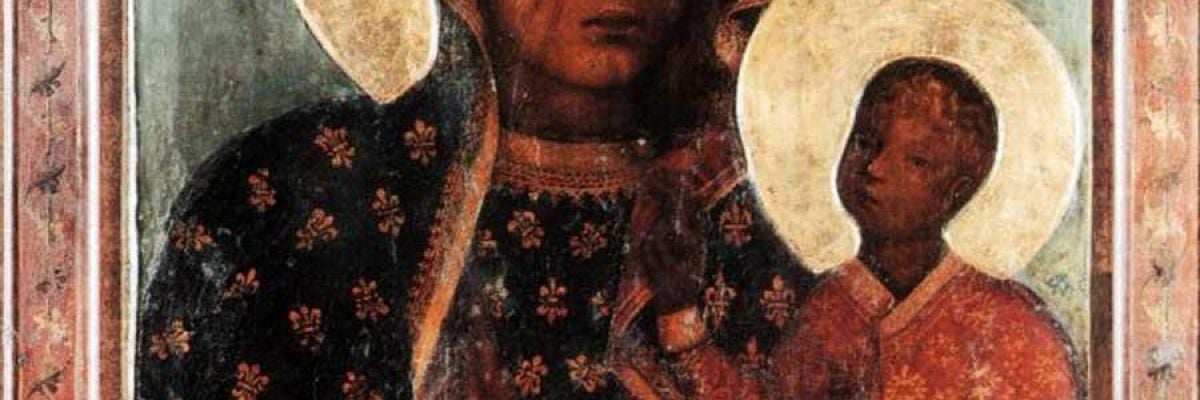
Who is the patron saint of apologetics?
Some people say Justin Martyr. Others Thomas Aquinas. Still others Francis de Sales or one of the Counter-Reformers.
All sound choices. St. Justin’s Apology, penned in the second century, is the archetype of written works defending Catholic doctrine. Aquinas settled the Manichees, and, if my memory serves, wrote some good stuff about the Faith himself. In addition to his tireless preaching in defense of the Church, St. Francis de Sales broadcast apologetics tracts and leaflets to great effect, almost singlehandedly rescuing the French Alpine region of Savoy from its dalliance with Calvinism. And who would say boo if one wanted to invoke the aid of Ignatius Loyola or Robert Bellarmine before undertaking some apologetical task? Not I.
I’d like to propose another, less conventional choice, though: Our Lady of Czestochowa, whose feast the Church celebrated Monday.
The Blessed Mother trumps any other saint, of course. But I won’t stop there. The icon of the Black Madonna, said by some to have come from the hand of St. Luke, and long associated with the Polish fortress-monastery of Jasna Góra, has been the locus of some of the most stirring defenses of the Faith in Catholic history.
According to pious tradition, the scars on her face came from an attack by followers of the proto-Protestant Jan Hus in 1430. It’s said the attackers did not escape with their lives—and ever since, the Black Madonna hasn’t been your average icon. This one means business.
Two centuries later, after the Reformation had claimed half of Europe and threatened to take more, Swedish Lutheran armies were tearing through Catholic Poland, making quick conquest of her large cities and causing the king to flee. They thought Jasna Góra and its sacred treasures would be easy plundering. But the monks and a small force of locals, inspired by the chief treasure within their walls, fought off the Swedes for a month—the prior at times even gently taunting them from the ramparts—until the vastly superior force withdrew.
In 1919-20, our Lady saved Catholic Poland again, this time from Soviet tanks aiming to supplant the Faith of Christ with the Gospel of Marx. On the cusp of losing the Polish-Soviet war, Poland appealed to Our Lady of Czestochowa for succor. Polish bishops met at Jasna Góra to invoke her aid, and the resulting “Miracle at the Vistula” (after reports of miraculous visions of the Blessed Mother in Warsaw) turned certain defeat into a decisive repelling of the Russian invaders.
Perhaps unsurprisingly, whether out of superstition or mere prudence, twenty years later when it was the Nazis’ turn to invade Poland, Hitler ordered troops not to plunder or despoil the monastery. It wouldn’t save him, though—or his plans to wrest Poland from the Queen of Heaven. Good thing, too, for that Queen and her battlement-shrine would be called upon to overcome the Communists one more time, rallying the Poles behind the charismatic young bishop who had dedicated himself totally to her: Karol Wojtyla.
Our Lady of Czestochowa never wrote a word, never preached a sermon, never engaged in a debate. But her mantle of care extends over all those who make it their work to defend the Faith. So it was that she inspired Hilaire Belloc, himself a grand patron of modern English-language apologetics, to write some of his finest verse, the Ballade to Our Lady of Czestochowa:
I
Lady and Queen and Mystery manifold
And very Regent of the untroubled sky,
Whom in a dream St. Hilda did behold
And heard a woodland music passing by:
You shall receive me when the clouds are high
With evening and the sheep attain the fold.
This is the faith that I have held and hold,
And this is that in which I mean to die.
II
Steep are the seas and savaging and cold
In broken waters terrible to try;
And vast against the winter night the wold,
And harbourless for any sail to lie.
But you shall lead me to the lights, and I
Shall hymn you in a harbour story told.
This is the faith that I have held and hold,
And this is that in which I mean to die.
III
Help of the half-defeated, House of gold,
Shrine of the Sword, and Tower of Ivory;
Splendour apart, supreme and aureoled,
The Battler’s vision and the World’s reply.
You shall restore me, O my last Ally,
To vengeance and the glories of the bold.
This is the faith that I have held and hold,
And this is that in which I mean to die.
Envoi
Prince of the degradations, bought and sold,
These verses, written in your crumbling sty,
Proclaim the faith that I have held and hold
And publish that in which I mean to die.



